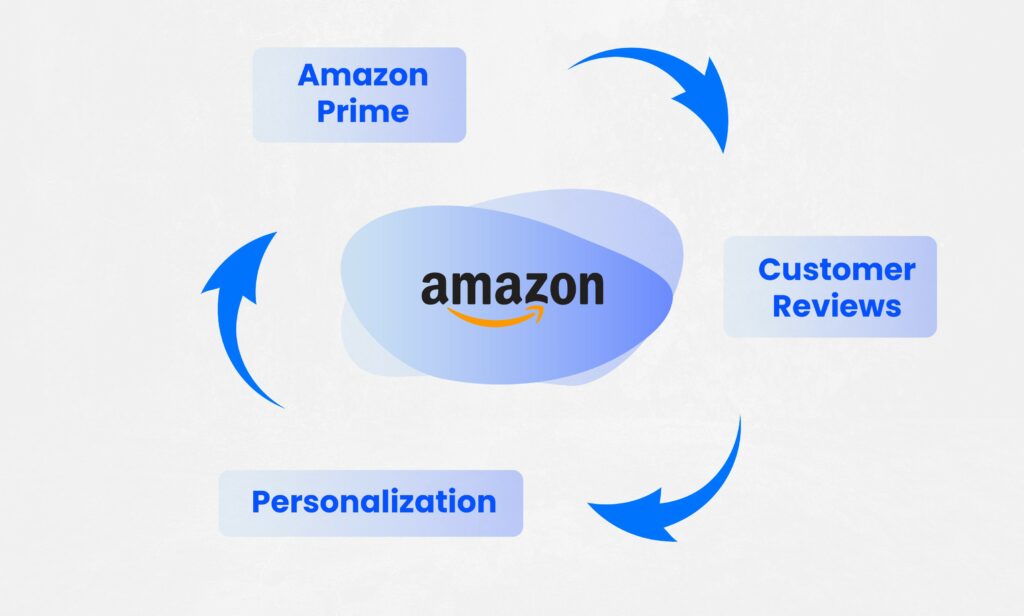If there’s one thing Amazon has mastered, it’s how to dominate the eCommerce market. But what is its secret? This blog post will discuss Amazon’s “flywheel” effect and how you can use it to benefit your own business. Read on to learn more!

Discover How To Supercharge Your Profits From Amazon & Beyond
Tech – unlock more revenue, increase efficiency & maximize profitability with integrated AI solutions
Agency Services – our ex-Amazonian team provides key insights, expertise & handles everything for you from A-Z
3PL Fulfillment Solutions – real-time inventory management connected to Eva tech across Amazon marketplaces
Table of Contents
What Is Flywheel Strategy?
The Flywheel strategy (also known as Growth Flywheel) is simple—keep your customers happy, and they will keep you in business. It’s a long-term strategy focusing on customer satisfaction and retention rather than short-term gains.
Nurturing existing customers is the cornerstone of success. Retaining an old customer is generally less expensive than finding a new one. Investing in delighted, loyal customers pays off!
The strategy has three key components: Attract, Engage, and Delight.
First, you need to attract customers with a compelling offer or experience.
Second, you must engage them by delivering on your promises and providing an excellent customer experience.
Finally, it would help if you delighted them by exceeding their expectations.
Understanding the basics of this idea may be straightforward. However, successfully executing it would require a Herculean effort across practically any brand.
Yet, Jeff Bezos, who introduced the Amazon Flywheel, found a way to implement this strategy.
By researching the Amazon Flywheel, you can identify strategies that work for your Amazon brand.
What Is The Amazon Flywheel?

The Amazon Flywheel is a marketing strategy designed to take advantage of customer experience to drive more traffic to the platform and third-party sellers.
Jeff Bezos set out to break the traditional retail model: purchasing, marketing, delivering, and pricing goods. To do this, he developed the “Amazon Flywheel.”
The Flywheel was an investment in systems that allowed customers to gain more value from Amazon beyond just prices.
This wheel supports every part of the customer experience—from providing accurate product information to building faster technology for delivery.
The concept behind this strategy is that a flywheel requires considerable initial effort. Once the wheel starts spinning, it gains momentum and moves faster over time effortlessly.
Consider the snowball effect. When you push a snowball down a hill, it progressively gets faster and faster until it reaches the bottom.
The flywheel strategy is similar in that it requires initial effort to get started. Still, once it’s in motion, it can generate significant momentum.
Amazon flywheel has been incredibly successful in driving growth for the company. By providing a world-class customer experience, Amazon has been able to attract more customers, which has helped Amazon become the go-to platform for online shopping.
Thanks to the flywheel effect, Amazon continues to grow at a fantastic rate, and there are no signs of this slowing down anytime soon.
How Does Amazon Flywheel Work?
The flywheel is a customer feedback loop integral to the company’s success. The flywheel comprises Amazon Prime, Amazon Web Services, and Amazon marketplace.
Prime is an exclusive membership that offers Prime customers free shipping and access to online streaming services.
Web Services by Amazon is a cloud computing platform that provides businesses with storage and other services.
Amazon marketplace is the world’s biggest online store where businesses can sell their products.
The flywheel works because each of these three parts reinforces the other.
For example, Amazon Prime customers are more likely to shop on Amazon, increasing the number of businesses that use Amazon Web Services.
This, in turn, increases the number of products available on the Amazon marketplace, making it more attractive to shoppers.
The result is a virtuous circle that keeps customers returning to Amazon repeatedly.
Related: What is Amazon Prime Day?
What Can Sellers Learn From Amazon Flywheel?
Amazon has built a flywheel business model that is the envy of many eCommerce businesses. It is a customer-feeding machine that keeps Amazon customers coming back for more. There are two takeaways from the Flywheel you should never forget.
First, the Amazon Flywheel starts with a focus on the customer experience. Amazon obsesses over delivering the best possible customer experience, and this obsession drives every decision.
From Amazon Prime to Amazon Fire TV, everything the top eCommerce site does is designed to keep customers returning for more.
This customer-centric focus is something that all Amazon sellers should imitate. You should put customer relations and feedback as the top priority of your business strategy to keep enhancing your service.
The other takeaway from the Amazon Flywheel effect is the design. It’s built to provide interdependent products and services to keep customers returning to one site for all different needs.
How can your brand do something similar to enhance the customer experience? Let’s discuss the advantages and explain how to move the flywheel.
The Advantage Of The Flywheel Effect On Your Amazon Business
The flywheel is a customer feedback loop that is the core of Amazon’s history-making success. It starts with customer satisfaction.
Customers who buy something on Amazon feel satisfied if it arrives on time and as described and order again. This satisfaction leads to customer loyalty, which leads to more sales and positive reviews.
The more customers Amazon has, the lower its prices can be, leading to even more customers and lower costs. It’s a never-ending cycle where all parties win.
The Flywheel effect is the key to Amazon’s success, which means ever-increasing traffic to Amazon.com, which is also great news for third-party sellers.
It is so powerful that it has allowed Amazon to dominate eCommerce, despite not having the first-player advantage as an online marketplace.
How to Create a Flywheel Effect for Your Own Amazon Store
The steps below help Amazon sellers like you implement your Flywheel to scale business growth. Try these out, and see how it impacts your business:
1. Laser-Focus On Customer Satisfaction
Customer satisfaction is the essence of everything and everything Amazon does. For example, suppose customers enjoy their time on the website. If so, they are more likely to buy more and return to the same place.
The same can be said of your Amazon store. Suppose you provide a 5-star customer experience and service. In that case, the odds are high that the customer will return to buy from you and introduce you to their family and friends.
2. Your Amazon Brand Requires Continuous Focus
Keeping your Amazon brand up-to-date and well-maintained can feel overwhelming from time to time, especially as customer expectations and trends are continuously shifting.
However, there is a solution; by focusing on advertising and creating a full-funnel strategy, you will not only bolster the success of your current campaigns but also give your brand flywheel the boost it needs to gain momentum.
The notable effects, including what you gain from trustworthiness, customer engagement, and sales, will keep your brand moving forward.
Crafting a plan focusing on long-term prosperity is the key to success, and it separates successful brands from unsuccessful ones. To win on Amazon, make sure you devote yourself to strategic implementation.
3. Make Your Business Interconnected & Interdependent
The flywheel effect promotes various aspects of your Amazon business together. For example, suppose you are SEO-optimizing your product listings to gain more organic traffic and boost sales.
By tapping into Amazon DSP & Ad Console, you will benefit from improved impressions and a lucrative advertising revenue stream with Amazon. It’s a win-win situation!
Sellers who understand how different Amazon business processes work will have the best experience creating an effective Amazon Flywheel strategy that maximizes revenue while improving customer retention processes.
Conclusion
The Amazon flywheel strategy is designed to create a snowball effect, where the more traffic that comes to the platform and third-party sellers, the more sales they make.
This virtuous circle can be turbocharged through effective advertising. If you’re looking for help getting your Amazon flywheel spinning, get your free PPC audit and discover how to maximize your profits as an eCommerce seller!








